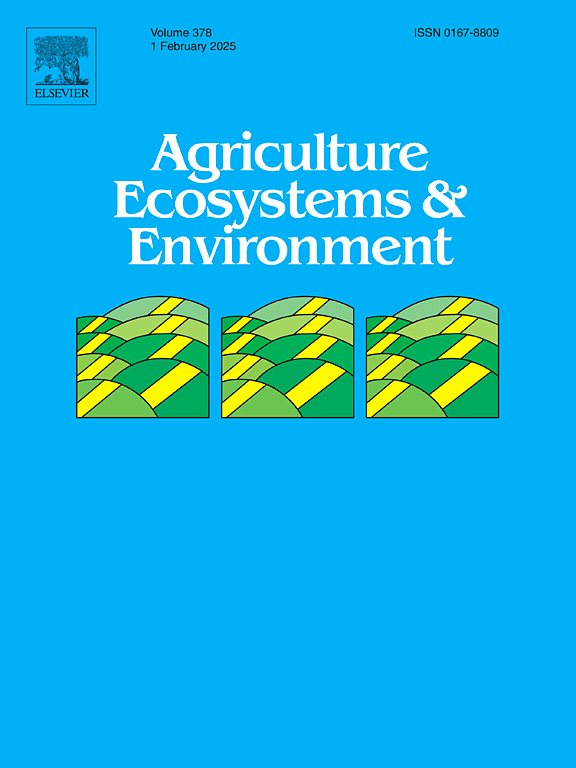侵蚀驱动下黄土高原不同空间尺度土壤有机碳和无机碳分布特征
IF 6.4
1区 农林科学
Q1 AGRICULTURE, MULTIDISCIPLINARY
引用次数: 0
摘要
上坡侵蚀带的泥沙沉积通常被认为是农业生产和生态恢复的肥沃土壤。然而,土壤有机碳(SOC)和无机碳(SIC)在侵蚀作用下的分布在不同空间尺度上的差异尚不清楚。在此基础上,研究了黄土高原侵蚀和沉积地形下土壤有机碳和碳化硅的剖面分布及其驱动因素。结果表明,碳化硅(SIC)与土壤有机碳(SOC)一样,对侵蚀反应敏感。在样地尺度上,土壤有机碳和碳化硅在侵蚀带和沉积带之间的差异很小,但在植被生物量最低的农田样地,土壤有机碳积累显著。在小流域尺度上,面积小、坡度陡的子流域沉积地形中有机碳和碳化硅含量较高,相反特征的子流域沉积地形中碳化硅含量较低。在区域尺度上,沉积地形中有机碳的富集程度在土壤侵蚀强度较大的地点较高,而侵蚀地形中有机碳的富集程度在轻度侵蚀和气候较宜人的地点较高。此外,在MAP较高的地点沉积的沉积物中,碳化硅被耗尽。表层土壤有机碳变化较大,深层土壤碳化硅变化较大。ΔSOC和ΔSIC (Δ =沉积-侵蚀)与植被生物量、集水区面积、MAT和MAP呈负相关,而与坡度和侵蚀模数呈正相关,表明它们受到侵蚀强度的增强。不同尺度下的土壤因子ΔSOC和ΔSIC均受初始C的负向影响,而Δclay+粉土对土壤因子有正向影响。综上所述,在不同的空间尺度上,沉积土壤的有机碳和碳化硅比侵蚀土壤的有机碳和碳化硅表现出富集、不变或耗竭的趋势,且随侵蚀强度的增大而增强。本文章由计算机程序翻译,如有差异,请以英文原文为准。
Soil organic and inorganic carbon distribution driven by erosion at various spatial scales on the Loess Plateau of China
Sediment deposition from upslope erosion zones is generally considered to be fertile for agricultural production and ecological restoration. However, how the distribution of soil organic carbon (SOC) and inorganic carbon (SIC) driven by erosion differed with spatial scales remains poorly understood. Here, the profile distribution and driving factors of SOC and SIC at the erosion and deposition topographies were investigated across multiple spatial scales on the Loess Plateau of China. Results showed that SIC, the major carbon (C) form, responded sensitively to erosion like SOC. At the plot scale, minimal differences in SOC and SIC were observed between erosion and deposition zones, except for a significant accumulation of deposited SOC in the cropland plot with the lowest vegetation biomass. At the small-catchment scale, SOC and SIC were higher in deposition topography for the sub-catchment with a smaller area and steeper slope, and SIC was depleted in deposited sediments for the sub-catchment with opposite characteristics. At the regional scale, the enrichment of SOC in deposition topography was greater in sites with more intense soil erosion, but the higher SOC in erosion topography was found in sites with light erosion and a more pleasant climate. In addition, SIC depleted for deposited sediments in sites with higher MAP. The variations of SOC were greater in surface soils, but the variations of SIC were greater in deep soils. ΔSOC and ΔSIC (Δ = Deposition – Erosion) were negatively related with vegetation biomass, catchment area, MAT, and MAP but positively related with slope gradient and erosion modulus, indicating that they were enhanced by the magnitude of erosion. As to soil factors, ΔSOC and ΔSIC at different scales were negatively affected by initial C but positively influenced by Δclay+silt. In conclusion, SOC and SIC can be enriched, unchanged, or depleted in deposited sediments than eroded soils relating to the spatial scales and the variations all strengthened by erosion magnitude at each scale.
求助全文
通过发布文献求助,成功后即可免费获取论文全文。
去求助
来源期刊

Agriculture, Ecosystems & Environment
环境科学-环境科学
CiteScore
11.70
自引率
9.10%
发文量
392
审稿时长
26 days
期刊介绍:
Agriculture, Ecosystems and Environment publishes scientific articles dealing with the interface between agroecosystems and the natural environment, specifically how agriculture influences the environment and how changes in that environment impact agroecosystems. Preference is given to papers from experimental and observational research at the field, system or landscape level, from studies that enhance our understanding of processes using data-based biophysical modelling, and papers that bridge scientific disciplines and integrate knowledge. All papers should be placed in an international or wide comparative context.
 求助内容:
求助内容: 应助结果提醒方式:
应助结果提醒方式:


